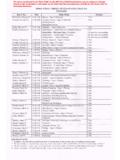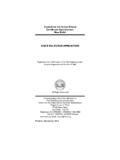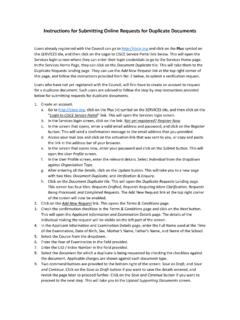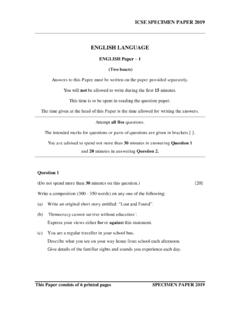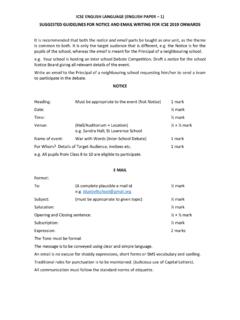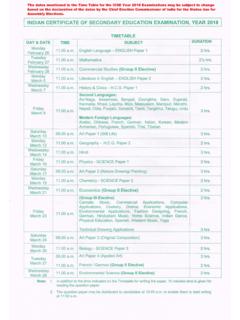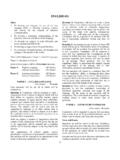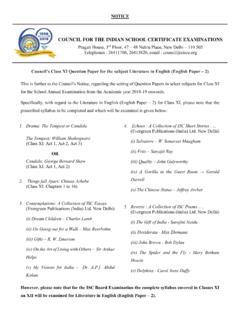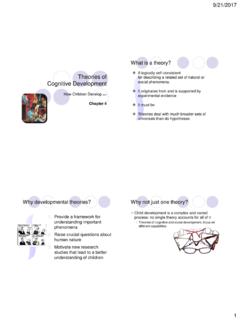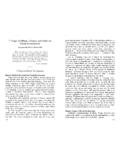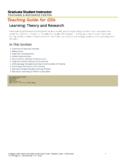Transcription of 12. ISC Psychology Scope - Revised
1 Psychology (855). Aims: (i) To develop an understanding of human (ii) To develop an understanding of the methods of behaviour: the nature of individuals and of research and study employed in Psychology . members of social groups. (iii) To develop an appreciation of the practical value of Psychology and its applications in daily life. CLASS XI. There will be two papers in the subject. Psychology .(Two Psychologists of each approach and their relevant concepts). Paper I - Theory: 3 hours 70 marks (ii) Fields of Psychology clinical, counselling, Paper II- Practical Work: 30 marks developmental, educational, organizational and social. PAPER - I (THEORY) 70 Marks The general importance and aims of studying Part I (20 marks) will consist of compulsory short Psychology and its special benefits. answer questions relating to the fundamental aspects Applications - different branches and the kind of the entire syllabus.
2 Of work done in special fields - clinical, Part II (50 marks) will consist of two sections, counselling, developmental, educational, A and B. organizational and social (in brief). Candidates will be required to answer two out of three (iii) Heredity and Environment meaning of the questions from Section A and three out of five term heredity'; basic principles and questions from Section B. Each question in this part mechanism of heredity. Meaning of the term shall carry 10 marks. environment; importance of both heredity and environment in behaviour. SECTION A. The role of chromosomes; the laws of 1. The Subject Psychology heredity: uniformity and variability. Significance of environment: physical and (i) Definition of Psychology ; Nature bio science, social. How both heredity and environment social science or pure science; schools of interact to produce behaviour.
3 Thought Structuralism, Functionalism, Behaviourism, Psychoanalysis, Gestalt 2 Methods of Psychology Psychology . (i) Scientific Methods in Psychology -observation, Definition of Psychology , subject matter / case study, surveys, psychological tests, nature of Psychology as a bio science, social experimentation steps. Psychological tests science or pure science. The eclectic approach and their uses. of modern Psychology . Emergence of The application of scientific methods in the Psychology as an independent discipline - study of behaviour. What is meant by different views regarding the nature scientific observation? Field study; controlled of this new subject. Approaches of James and uncontrolled observation; longitudinal Watson and Freud. Main features of the and cross-sectional studies; the case history schools of Structuralism, Functionalism and method; the experimental method - variables Behaviourism, Psychoanalysis, Gestalt and controls - steps in an experiment; surveys and use of questionnaires/self reports.
4 58. Meaning of samples - random, biased, psychological factors attributes of colour - representative population. Psychological hue, brightness and saturation; laws of colour tests - definition, uses. mixture; colour blindness, adaptation and (ii) Interpretation of research results use of after-images. statistics in interpretation of data - (iii) Errors in perception - illusions of size and understanding of why statistics is used shape; what is meant by extra-sensory (descriptive & inferential). Basic statistical perception (ESP). concepts statistics, sample, population. False interpretations - illusions: Muller-Lyer, Why statistics is used in Psychology - Height -Width, Ponzo, Zoellner, Poggendorf interpretation of findings: describing and (details of experiments are required); ESP - summarizing data, comparing individuals/ perceptions not based on any of the known groups, investigating relationships between senses (general understanding of ESP).
5 Variables, predicting. Descriptive statistics - SECTION B. for summarizing scores. Inferential statistics - to determine whether observed differences 4. Emotions and Motivation between groups are likely/unlikely to have (i) What is meant by emotion; the basic emotions. occurred by chance. Subjective and cognitive experience, How scores are grouped into frequency physiological reactions and overt expression. distributions; central tendency of a frequency Primary emotions - fear, anger, joy, sorrow, distribution - mean, median, mode and when affection. each measure is used; dispersion: the extent to (ii) Theories of emotion dealing with physiological, which scores are spread out - range, variance, subjective and cognitive aspects. standard deviation; why both central tendency James Lange, Cannon Bard, Schachter - and variability are important in Psychology .
6 Singer theories. 3. Attention and Perception (iii) What is meant by motives, needs and instincts;. unconscious motives. (i) Nature of attention - its inner and outer determinants. Motivation as an internal force generating certain behaviour - biological The importance of attention in perception - needs and homeostasis; instincts as how both physical factors such as size, colour, unlearned and physiological desires; evidence movement, change, intensity, contrast and indicating the existence of unconscious psychological factors such as need, interest motives. Intrinsic - the desire to perform and emotion determine attention and activities for their own sake. perception. (iv) Theories of Motivation. (ii) Perceptual processes - difference between Pull and push theories, Optimum Arousal sensation and perception.
7 Organizational theory and Expectancy theory - Graphic principles of perception - laws, constancies, representation of Maslow's Needs Hierarchy. depth and colour perception. (v) Social motives. Process involved in transforming sensation to Three distinctively human motives: perception. Important factors in perceptual Achievement - accomplishing difficult tasks;. process - figure and ground, laws of Power - exerting influence over others;. grouping: similarity, proximity, continuation, Aggression - learning and control of human simplicity, good figure; constancy of size, aggression, causes and effects. shape and colour; factors involved in depth perception -monocular and binocular cues;. how colour is perceived - biological and 59. (vi) Frustration - blocking of motives; conflict (iii) How memory can be improved.
8 Among motives. Attention, use of imagery, Mnemonic devices, Frustration as a result of motives not finding application of principles of learning. free or adequate expression. Different types of conflict among motives: approach-approach, 7. Thinking, Problem Solving and Creativity avoidance-avoidance, multiple approach- (i) What is meant by thinking. avoidance (with examples). Nature and elements of thinking: images, concepts and language - interdependence of 5. Learning language and thought; different kinds of (i) What is meant by learning; how learning takes thinking: convergent, divergent, creative, place - Classical and Operant Conditioning; goal-oriented and aimless thinking. Insight learning, Observational Learning and (ii) Concepts and how they are formed. Learning Styles. Definition - importance of concepts in Definition of learning - Pavlov and Classical thinking - artificial, natural, simple and Conditioning; Thorndike and Trial and Error; complex concepts.
9 Skinner and Operant Conditioning; (iii) Reasoning - how it is carried out; common experiments, findings and principles errors in reasoning, how reasoning can be made established. Insight and Observational more effective. Decision making and problem Learning - Kohler and Bandura's studies. solving - heuristics and algorithms. Learning Styles Auditory, Visual and Reaching specific conclusions from available Kinesthetic information - deductive and inductive (ii) Learning disabilities: definition and types. reasoning; common errors - faulty premises, biases, fallacy of single case, rationalization, Characteristics of the disabilities - Dyslexia, hindsight. Improving reasoning - avoiding dyscalculia, dysgraphia, dyspraxia. errors, examining premises and ambiguities, Adjustment problems and coping with guarding against emotion.
10 Decision Making academics (symptoms and management). and Problem Solving - steps involved, 6. Remembering and Forgetting optimum expected utility, means-end-analysis, analogy. (i) The memory system - how it works - different (iv) Creative thinking - what is meant by models. convergent and divergent thinking; stages in Sensory memory, Short and Long term creative thinking, how creativity can be Memory - encoding, storage, retrieval. fostered. Semantic and Procedural Memory. Processing Use of divergent thinking in creativity - stages memory - the Atkinson Shiffrin Model and in creative thinking, preparation, incubation, Parallel Distributed Processing. illumination, verification/validation. How (ii) Why and how forgetting occurs. creativity may be encouraged: enrich knowledge and experience, encourage Trace decay, retro and pro active independence, curiosity and promote positive interference, amnesia - retrograde and mood.
